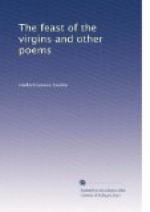“Yes; they fight among themselves—away off. Do you hear the thunder of their big guns? No; it would take you two moons to run down to where they are fighting, and all the way your path would be among white soldiers as thick as tamaracks in the swamps of the Ojibways. Yes; they fight among themselves, but if you strike at them they will all turn on you and devour you and your women and little children just as the locusts in their time fall on the trees and devour all the leaves in one day. You are fools. You cannot see the face of your chief; your eyes are full of smoke. You cannot hear his voice; your ears are full of roaring waters. Braves, you are little children—you are fools. You will die like the rabbits when the hungry wolves hunt them in the Hard Moon (January). Ta-o-ya-te du-ta is not a coward: he will die with you.”
[7] Harps-te-nah. The first-born daughter of a Dakota is called Winona; the second, Harpen; the third, Harpstina; the fourth, Waska; the fifth, Weharka. The first-born son is called Chaske; the second, Harpam; the third, Hapeda; the fourth, Chatun; the fifth, Harka. They retain these names till others are given them on account of some action, peculiarity, etc. The females often retain their child-names through life.
[8] Wah-pah-sah was the hereditary name of a long and illustrious line of Dakota chiefs. Wabashaw is a corrupt pronunciation. The name is a contraction of Wa-pa-ha-sa, which is from Wa-ha-pa, the standard or pole used in the Dakota dances and upon which feathers of various colors are tied, and not from Wa-pa—leaf, as has been generally supposed. Therefore Wapasa means the Standard—and not the “Leaf-Shaker,” as many writers have it. The principal village of these hereditary chiefs was Ke-uk-sa, or Ke-o-sa,—where now stands the fair city of Winona. Ke-uk-sa signifies—The village of law-breakers; so called because this band broke the law or custom of the Dakotas against marrying blood relatives of any degree. I get this information from Rev. Stephen R. Riggs, author of the Dakota Grammar and Dictionary, “Takoo Wakan,” etc. Wapasa, grandfather of the last chief of that name, and a contemporary of Cetan-Wa-ka-wa-mani, was a noted chief, and a friend of the British in the war of the Revolution. Neill’s Hist. Minn., pp. 225-9.
[9] E-ho, E-to—Exclamations of surprise and delight.
[10] Mah-gah—The wild-goose.
[11] Tee-pee—A lodge or wigwam, often contracted to “tee.”
[12] Pronounced Mahr-pee-yah-doo-tah—literally, Cloud Red.
[13] Pronounced Wahnmdee—The War Eagle. Each feather worn by a warrior represents an enemy slain or captured—man, woman or child; but the Dakotas, before they became desperate under the cruel warfare of their enemies, usually spared the lives of their captives, and never killed women or infants, except in rare instances under the lex talionis. Neill’s Hist. Minn., p. 112.




